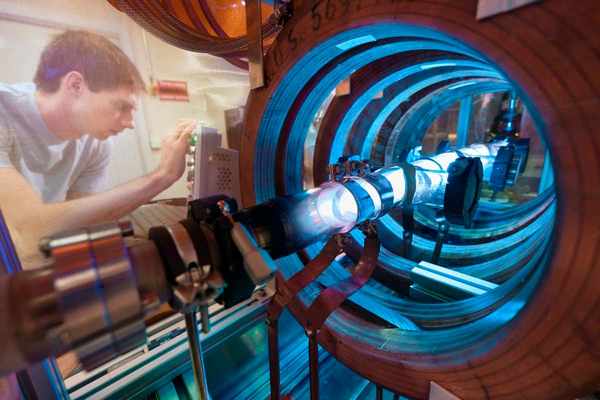PATHFINDERS – HOW MUCH DOES DARK MATTER?

SOCIALIST STANDARD no-1435-march-2024
Pure science, from a capitalist point of view, is a bit like kissing frogs. You have to kiss a lot of frogs before one turns into a handsome princely profit. Sometimes – rarely – a technical project offers a large and obvious return on investment (ROI), even though the payout might be years or even decades away. With nuclear fusion, for example, the potential ROI is enormous and alluring, but while the boffins swear the idea works in theory, the technical challenges of putting the sun in a box are immense and not always known in advance, which usually means spiralling costs. The €5bn price tag for the experimental Iter fusion plant in southern France has more than quadrupled to €22bn, and now the schedule has been put back a further ten years. This puts European state investors in something of a sunk-cost bind. The risk of fusion never working is not as bad as it working, and China or Russia getting the jump on it. The British state recently managed to Brexit itself out of the Iter project, but Euro-governments generally see no option but to continue shovelling money into it.
Nothing about science is guaranteed. Even if it works, it might never result in any marketable technology. One project that paid off is the Large Hadron Collider (LHC) at CERN in Switzerland, the rarest kind of all-level success story. As is commonly known, protons and neutrons are not fundamental particles, but are made up of combinations of quarks. Such combinations go by the name of hadrons, and smashing them together at super-high speed to see what pops out seemed like a very good idea, from the boffins’ point of view. From a government funding point of view, the ultimate composition of matter promised no ROI that mattered, but since one can never be sure, and because this was leading-edge research, they rolled the dice anyway.
CERN proved to be a smashing success, discovering more than 50 new hadrons, not to mention the Higgs boson in 2012 (tinyurl.com/yeyn92vk). It also unexpectedly spawned a side-bonanza for capitalism that had nothing to do with hadrons, or even physics. Tim Berners-Lee, a computer scientist working at CERN, came up with the worldwide web, which revolutionised capitalism.
So, CERN has become the poster child for capitalist science in Europe. But the hard questions of physics remain intractable. The ‘standard model’ has gaping holes. Assuming that Einstein’s theory of gravity is correct even at the largest scales, there should be around another 30 percent of ‘stuff’ in the universe to explain why galaxies don’t spin themselves to bits. No current device can detect this ‘dark matter’. Furthermore, nobody can explain why the universe is expanding at an accelerating rate, except with a putative ‘dark energy’ which represents 70 percent of ‘stuff’ but also can’t be detected.
Since smashing stuff together seems to work, experimental physicists have proposed an obvious solution – smash even more stuff together even more violently with a vastly bigger installation. They want to build the Future Circular Collider (FCC), a €20bn monster that would make the LHC look like a desktop pinball game (tinyurl.com/mr2vj67j). But this proposal to find fundamental answers raises fundamental questions about what investors are willing to stump up for.
The problem is, if the FCC enthusiasts are saying €20bn now, and if Iter is anything to go by, the actual cost could end up being multiples of this estimate. Euro ministers are choking on their lattes at the idea, and even some physicists are calling it ‘reckless’ and questioning whether ‘bigger, faster, harder’ is the best way to go. The biggest possible Earth-based collider could anyway never achieve more than a fraction of the colossal energies released in cosmic rays, meaning such exotic conditions will always be out of reach. And what if dark matter turns out not to exist, and is instead, like phlogiston, a supposition based on a wrong theory? Then, obviously, the FCC won’t find it. Would the boffins then demand even bigger and more expensive colliders, one after another, until they’ve got one the size of the solar system? Besides, with the climate crisis, pandemics, AI and other more immediate concerns, aren’t there bigger priorities for science budgets right now?
Government money comes from taxes on profits, which the rich get by exploiting us workers. We don’t get any say in how governments spend this cash, but the rich certainly do have an influence. And it’s a moot question how much the nature of reality actually matters to them, especially when the costs keep going up. Will they get tired of stuffing coins into the fruit machine of physics and watching the lemons whizz by?
Workers, meanwhile, have a more pressing concern, to get rid of capitalism and the rule of the rich. But a socialist society will still have to answer the fundamental question, which is how badly we want to know and how hard we are collectively prepared to work to find out. There’s always the possibility that people in socialism will not be willing to construct mega-colliders, despite what physicists say, and will decide to put their creative efforts into other things like space exploration, or undersea cities, or transhumanism, or rewilding the planet, or creating great art. But there’s no doubt that human beings do value the quest for knowledge for its own sake, in any society that claims to be civilised. The specific problem for science in capitalism is that it has to follow capitalism’s skewed money-agenda, where lofty goals may be celebrated, but the decisive factor is usually the bottom line, the factional advantage, and that all-important ROI.
PJS
No comments:
Post a Comment